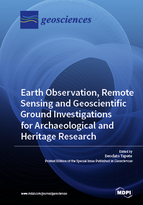Earth Observation, Remote Sensing and Geoscientific Ground Investigations for Archaeological and Heritage Research
A special issue of Geosciences (ISSN 2076-3263).
Deadline for manuscript submissions: closed (31 October 2018) | Viewed by 98029
Special Issue Editor
Interests: earth observation; radar and optical remote sensing; InSAR; time series analysis; Earth Sciences; environmental geology; natural hazards; urban environments; geoheritage; geoconservation; cultural heritage
Special Issues, Collections and Topics in MDPI journals
Special Issue Information
Dear Colleagues,
The first Special Issue of Geosciences on “Remote Sensing and Geosciences for Archaeology” collected more than 20 high-quality peer-review papers outlining the state-of-the-art of research in the fields of archaeological remote sensing and geosciences.
Building upon this success, this second edition aims to gather original research articles, reviews and technical notes, on how Earth Observation (EO), Remote Sensing (RS) and geoscientific ground investigations mutually complement to achieve accurate and reliable detection and prospection of surface and subsurface archaeological records, as well as condition assessment of heritage assets.
It is nowadays a common practice that signals, parameters, features and marks extracted from EO and RS analyses are compared with ground truth collected during validation surveys and/or with contextual measurements from ground-based and in-situ sensors.
However, there is a wide variety of methods and only few of them have developed into established standards. On the other hand, technological advancement and new EO facilities are pushing researchers and practitioners to develop new or refine existing methodologies.
Therefore, I would like to invite you to submit articles about your recent work, experimental research or case studies, with respect to the above topic and falling within one of the following domains:
- Archaeological prospection
- Digital archaelogical fieldwork
- Condition assessment of heritage assets
- GIS analysis of spatial settlement patterns in modern landscapes
- Assessment of natural or human-induced threats to conservation
- Education and capacity building in EO, RS for archaeology
I also encourage you to approach me by sending a short abstract outlining the purpose of the research and the principal results obtained, in order to verify at an early stage if the contribution you intend to submit fits with the objectives of the Special Issue.
Dr. Deodato TapeteGuest Editor
Manuscript Submission Information
Manuscripts should be submitted online at www.mdpi.com by registering and logging in to this website. Once you are registered, click here to go to the submission form. Manuscripts can be submitted until the deadline. All submissions that pass pre-check are peer-reviewed. Accepted papers will be published continuously in the journal (as soon as accepted) and will be listed together on the special issue website. Research articles, review articles as well as short communications are invited. For planned papers, a title and short abstract (about 100 words) can be sent to the Editorial Office for announcement on this website.
Submitted manuscripts should not have been published previously, nor be under consideration for publication elsewhere (except conference proceedings papers). All manuscripts are thoroughly refereed through a single-blind peer-review process. A guide for authors and other relevant information for submission of manuscripts is available on the Instructions for Authors page. Geosciences is an international peer-reviewed open access monthly journal published by MDPI.
Please visit the Instructions for Authors page before submitting a manuscript. The Article Processing Charge (APC) for publication in this open access journal is 1800 CHF (Swiss Francs). Submitted papers should be well formatted and use good English. Authors may use MDPI's English editing service prior to publication or during author revisions.
Keywords
- Earth Observation
- remote sensing
- in situ measurements
- ground-based sensors
- data processing
- analytical methods
- data integration
- validation
- accuracy assessment
- archaeological prospection
- digital archaeological fieldwork
- condition assessment
- pattern recognition
- capacity building






